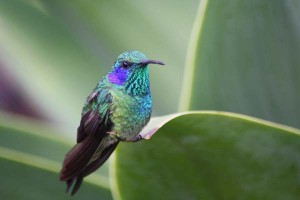Latest update November 15th, 2024 1:00 AM
Green violetear
Oct 25, 2015 Features / Columnists, Interesting Creatures in Guyana
The green violetear (Colibri thalassinus) is a medium-sized, metallic green hummingbird species commonly found in forested areas from Mexico to northern South America.
The green violetear belongs to the order Apodiformes. Hummingbirds share this order with the swifts, such as the white-collared swift. The name Apodiformes is derived from the Greek words “a pous,” meaning “without foot.” While apodiforms do in fact have feet, they are quite small and their legs are short and relatively weak. Many birds in this order cannot walk, and thus rarely if ever land on the ground since quick escape from predators is virtually impossible. For this reason members of this order spend a majority of their time in the air.
The violetear genus (Colibri) includes three other species: sparkling violetear, brown violetear, and white-vented violetear. The green and sparkling violetears are similar in appearance and overlap in range but are generally found at different altitudes and in different habitats. These four hummingbirds are characterized by their violet ear patches. In all four species there is no strong sexual dimorphism.
The green violetear is roughly medium-sized by hummingbird standards. It averages around 9.7 to 12 cm (3.8 to 4.7 in) in total length. Its bill is black and mostly straight with only a slight downward curve and measures from 1.8 to 2.5 cm (0.71 to 0.98 in). The body mass can vary from 4.8 to 5.6 g (0.17 to 0.20 oz). Among standard measurements, the wing chord is 5.8 to 6.8 cm (2.3 to 2.7 in) and the tail is 3.5 to 4.3 cm (1.4 to 1.7 in). It is shining green above with a glittering violet ear-patch on the sides of its neck. Its throat and chest are a more glittering green with a shining green belly. The tail is a metallic blue-green with more bronzy central feathers and a prominent black sub-terminal band.
Solitary males sing from high, exposed twigs in their territory every day. Their song is a monotonously repeated sharp and dry “tsu-tzeek” at a rate of about one call per second.
The green violetear breeds from the highlands of southern Mexico south to Honduras; the highlands of Costa Rica and western Panama; mountains of northern Venezuela, and the Andes from western Venezuela to western Bolivia. It is a rare but annual non-breeding visitor to the United States, primarily southern and central Texas, with scattered records as far north as extreme southern Canada.
The green violetear forages alone but tends to gather at flowering trees, especially coffee-shade Inga. They feed at mid-level to canopy and often hold and defend a feeding territory. They primarily feed on nectar and small insects. The green violetear has been recorded as attaining the greatest flying speed ever recorded for a hummingbird, with a pair of birds having attained 90 mph (140 km/h) during a chase, although other species may be able to attain similar speeds.
Like most hummingbirds, the green violetear is a solitary nester. The male’s only involvement in the breeding process is to attract and mate with the female. The female is then responsible for choosing a nest location, generally on a low, small horizontal branch in a protected area. The nest is small and built from various plant materials, spider webs, and down woven together to form a sturdy cup structure. Two small white eggs are laid within the nest and the female incubates them on her own. Incubation time is 14–18 days. Hatchlings are primarily fed insects due to high nutritional requirements. No information was found on the length of the nestling stage or age at fledgling. Breeding takes place through the wet season into the early dry season, which varies by latitude.
Seasonal movements of the green violetear are not well understood. Many individuals of northern populations move south or and/or to lower elevations following the end of the breeding season (July to November in Mexico), but regular occurrence hundreds of kilometres north of this range suggests a more complex migration strategy. (Source: Wikipedia – the Free Online Encyclopedia)
Share this:
- Click to print (Opens in new window)
- Click to email a link to a friend (Opens in new window)
- Click to share on Facebook (Opens in new window)
- Click to share on WhatsApp (Opens in new window)
- Click to share on Twitter (Opens in new window)
- Click to share on Pinterest (Opens in new window)
- Click to share on Pocket (Opens in new window)
- Click to share on Tumblr (Opens in new window)
- Click to share on Reddit (Opens in new window)
- Click to share on LinkedIn (Opens in new window)
Related
Similar Articles

The Glenn Lall Show | November, 11th, 2024
Follow on Tik Tok @Glennlall
THE BLUNT OF THE DAY

Sports
Nov 15, 2024
2024 GCB BetCAGESports National T20 League… Kaieteur Sports- Ahead of today’s semi-finals of the GCB BetCAGESport National T20 League, the four respective captains said each of their...Features/Columnists
The Jagdeo Jig!
…Peeping Tom Kaieteur News-Vice President Bharrat Jagdeo has become master of sidestepping, shuffling, and even pirouetting... more
Rising Gun Crimes in the Caribbean: Urgent Action required by all
By Sir Ronald Sanders Kaieteur News – There is an alarming surge in gun-related violence, particularly among younger... more
Publisher’s Note
Freedom of speech is our core value at Kaieteur News. If the letter/e-mail you sent was not published, and you believe that its contents were not libellous, let us know, please contact us by phone or email.
Feel free to send us your comments and/or criticisms.
Contact: 624-6456; 225-8452; 225-8458; 225-8463; 225-8465; 225-8473 or 225-8491.
Or by Email: [email protected] / [email protected]
Weekend Cartoon














